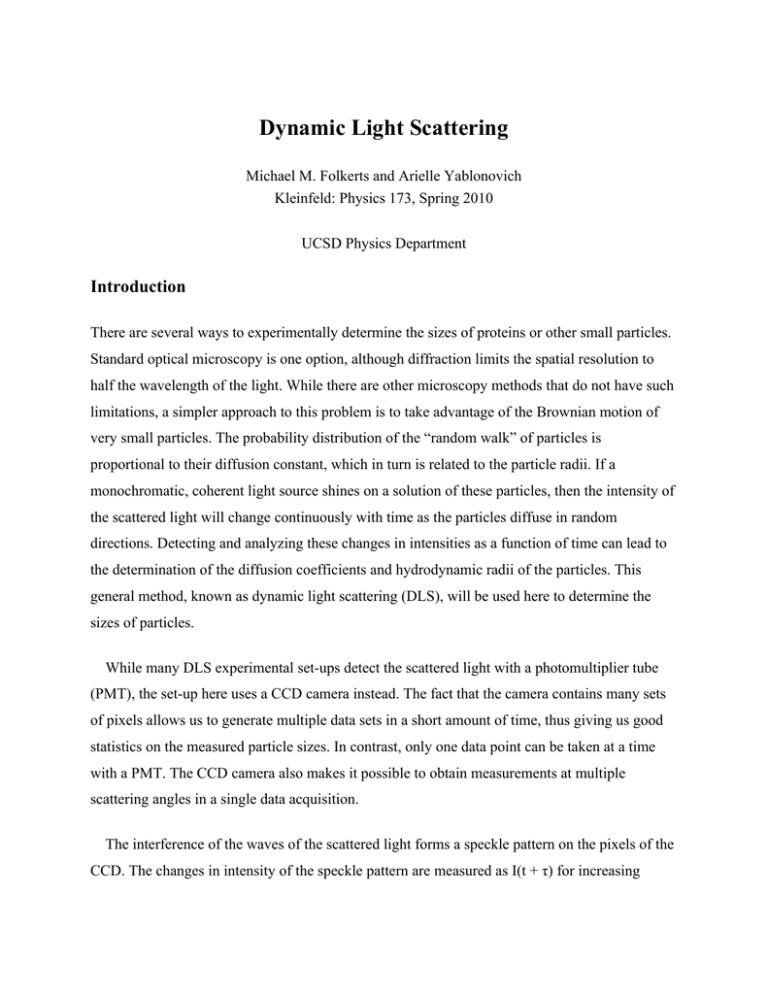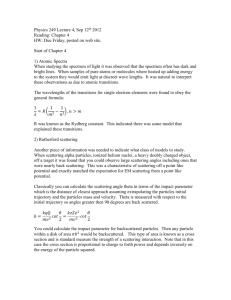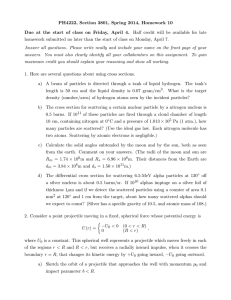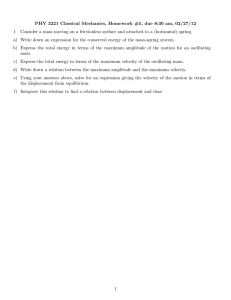Dynamic Light Scattering
advertisement

Dynamic Light Scattering Michael M. Folkerts and Arielle Yablonovich Kleinfeld: Physics 173, Spring 2010 UCSD Physics Department Introduction There are several ways to experimentally determine the sizes of proteins or other small particles. Standard optical microscopy is one option, although diffraction limits the spatial resolution to half the wavelength of the light. While there are other microscopy methods that do not have such limitations, a simpler approach to this problem is to take advantage of the Brownian motion of very small particles. The probability distribution of the “random walk” of particles is proportional to their diffusion constant, which in turn is related to the particle radii. If a monochromatic, coherent light source shines on a solution of these particles, then the intensity of the scattered light will change continuously with time as the particles diffuse in random directions. Detecting and analyzing these changes in intensities as a function of time can lead to the determination of the diffusion coefficients and hydrodynamic radii of the particles. This general method, known as dynamic light scattering (DLS), will be used here to determine the sizes of particles. While many DLS experimental set-ups detect the scattered light with a photomultiplier tube (PMT), the set-up here uses a CCD camera instead. The fact that the camera contains many sets of pixels allows us to generate multiple data sets in a short amount of time, thus giving us good statistics on the measured particle sizes. In contrast, only one data point can be taken at a time with a PMT. The CCD camera also makes it possible to obtain measurements at multiple scattering angles in a single data acquisition. The interference of the waves of the scattered light forms a speckle pattern on the pixels of the CCD. The changes in intensity of the speckle pattern are measured as I(t + τ) for increasing values of τ. This information can be used to graph the autocorrelation function, which describes changes in a particular measurement as a function of the time separation between the measurements (τ). This function can then be fit to a decaying exponential, and the information obtained from this fit will allow us to calculate the diffusion constants and radii of the particles. In performing these measurements, we sought to see how changing one particular variable at a time changes our output data, and figuring out why the variable affects the system in that way. Although all measurements were performed with beads, this set-up could also be used to find the hydrodynamic radii of proteins, or to analyze the binding and aggregation of proteins or nanoparticles. Methods A 633nm laser with a 1mm diameter beam is used as the monochromatic light source for scattering. The CCD camera is a Basler spL2048-140km with two rows of 2048, 10μm by 10μm pixels. We turned on horizontal and vertical binning to increase our photon count. Binning increased the effective size of the detector to one row of 1024, 20μm by 20μm pixels. The scattering angle was calculated for each pixel using the schematic in Figure 1. Figure 1: Illustration of our experimental setup. The scattering angle 𝛳 (for each pixel) is defined as the equipment angle (90 degrees in this case) minus 𝛼, the angle from the aperture to each of the pixels. The scattering volume is defined by the overlap of the projection of each pixel through the aperture with the cylinder of illuminated by the laser beam. The speckle size is defined as the location of the first dark fringe in far field diffraction for a given aperture with diameter a. When the path length difference becomes 1/2 wavelength, the speckle size is equal to λL/a, where λ is the wavelength of the light and L is the distance between the aperture and the detector. We set the speckle diameter equal to the size of a pixel, to get a strong signal without mixing of adjacent speckles. With a pixel size of 20 μm, L = 11 cm and λ = 633 nm, we obtain an aperture diameter of 3.5 mm. Due to the refraction that occurs across the cuvette boundary, we had to adjust our calculation to back trace the scatting angle. Sample Preparation Polystyrene beads diluted in water were used for measurements. The bead solutions were put in square plastic cuvettes. Prior to taking measurements, the bead samples were vortexed for approximately ten seconds. In the experimental apparatus, the cuvette was placed as close as possible to the aperture, while still allowing for the entire laser beam to pass through the sample. With this constraint the illumination volume was located about 1mm from the cuvette wall. Theory Particles in a mixture will diffuse in random directions. According to Brownian motion, the probability of finding a particle at position r at time t is: where D is the diffusion coefficient of the collection of particles. According to the StokesEinstein equation, the diffusion coefficient is related to the hydrodynamic radii RH in the following way: where kB is the Boltzmann constant, T is temperature, and η is the viscosity of the solvent. The change in momentum between the incident light and scattered light is q: Here, n is in the index of fraction of the solution, λ is the wavelength of the incident light, and θ is the scattering angle: The common approach in dynamic light scattering (DLS) is to auto-correlate intensity measurements as a function of offset time. Where the intensity I measured by our charged couple device (CCD) detector is the square of the scattered wave vector. Following the derivation set forth in [1] one can equate the the autocorrelation function to an exponential. This exponential equation can be used to obtain the diffusion coefficient D, and subsequently the hydrodynamic radius of the beads: Data Analysis A collection of MATLAB scripts where created to analyze our raw data. These scrips can be found in the code folder included with this report. Basic outline of code: Correlate pixel data. Fit autocorrelation function for each pixel in detector: Save Dq2 value (decay frequency) for each pixel. Calculate q value for each pixel using Snell's law, definition of q, equipment and pixel angle. Plot Dq2 vs. q2 along with theoretical value. Average over q values and Dq2 and use these value to compute RH. Results/Data The following figures and tables include raw data from the CCD camera, graphs of the decay rate as a function of bead concentration and equipment angle, graphs of the autocorrelation function itself, and tables showing our measurements of the bead radii. The two bead diameters measured were 214 nm and 2.9μm. The different theoretical lines take into account the width of the aperture, as well as +/- 0.5 degrees Celsius in the temperature of the bead samples. Figure 2: Raw data of 2.9um dia. beads for fractional concentrations. Figure 3: This is a sample autocorrelation fitting for one pixel in the 2.9um dia. data set at 1/16 relative concentration and 90 deg. equipment angle. Figure 4: This plot shows the dependence of our data on the concentration of 2.9um dia. beads. Each point represnts an average over all detector pixels. The error bars represent one standard deviation. Figure 5: This plot shows the dependence of our data on the concentration of 214nm dia. beads. Each point represnts an average over all detector pixels. The error bars represent one standard deviation. Figure 6: Raw data for 214nm dia. particles for different equipment angles. Figure 7: This is a sample autocorrelation fitting for one pixel in the 214nm dia. data set taken at 33 deg. equipment angle. Figure 8: This plot shows the q dependence of the decay rates. Each point represnts an average over all detector pixels. The error bars represent one standard deviation. Table 1: 0.107 μm Bead Data, by Concentration (90 deg. equipment angle) Billions of Particles per mL Measured Bead Radius % Error in (μm) Average Intensity/ exposure time Radius 1000 (μs) 4.9 0.1005 10% 2.9036 100 9.8 0.0998 9.50% 2.8347 100 19.6 0.0932 13.90% 2.8979 100 39.2 0.1006 9.80% 4.1421 100 78.4 0.0886 18.80% 2.8227 100 Table 2: 1.45 μm Bead Data, by Concentration Millions of Particles per mL Measured Bead Radius % Error in (μm) Average Intensity/ exposure time Radius 1000 (μs) 3.3 0.987 31.90% 3.9179 800 6.6 1.03 29.20% 4.7708 400 13.1 0.586 59.40% 5.2231 400 26.3 0.421 70.80% 6.0248 200 52.5 0.569 60.10% 3.9985 200 105 0.399 72.10% 5.5456 200 Table 3: 0.107 μm Bead Data, by Scattering Angle (9.8x10^9 Particles/mL) Equipment Angle (deg.) Measured Bead Radius % Error in (μm) Average Intensity/ exposure time Radius 1000 (μs) 33 0.04 65.80% 5.3862 100 47 0.058 45.40% 5.8303 100 64 0.079 26.70% 4.103 100 90 0.099 9.50% 2.8347 100 104 0.106 5.20% 2.8347 100 Discussion We measured the hydrodynamic radii of two different sized beads using dynamic light scattering, and determined which experimental variables played a significant role in the results. Square cuvettes gave the most accurate results, compared to round glass test tubes and UVettes. The square geometry also made it easier to calculate the effect of refraction. Changing the size of the aperture did not influence the results signficantly, and was fixed according to the speckle size calculation, as mentioned in the Methods section. Increasing the depth, or distance between the beam and the aperture, increased the decay rate of the autocorrelation function by a significant amount. We suspect that this increase was due to multiple scattering as scattered light would pass through more of the sample, thereby increase the probability of a second scattering event. The bead sizes were characterized as a function of concentration and scattering angle. As the scattering angle decreases, the inaccuracy of our measurements increased. The decay rate does not increase signficantly as the bead concentration increases, as seen by the overlap in error bars. The decay rate increases more noticeably as the scattering angle increases. The system gave the most accurate results at an equipment angle of 90 degrees, using the smaller 214 nm beads, and with a concentration in the range of billions of particles per mL. There is no clear explanation for why this is the case, although the accuracy of our measurements in general may reflect a balance between the strength of the signal and multiple scattering. More specifically, an increase in the number of "scatterers" will result in more scattered light and thus a stronger signal, but too many "scatterers" will lead to multiple scattering. Dynamic light scattering assumes that the beads in the solution are all the same size. The standard deviation of the bead radii provided by the manufacturer is only around 3.1% for the 214 nm diameter beads and 3.7% for the 2.9 μm diameter beads, so this may partially contribute to the inaccuracies in our measurements. In addition, the measurements are very sensitive to temperature, since this variable is directly in the Stokes-Einstein equation, as well as the viscosity and index of refraction of the particle solution. It is possible that the sample was heated from the laser beam or the CCD camera, thus yielding us inaccurate results. Temperature fluctuations may have also affected the results. The shot noise from the CCD camera is another important thing to consider in interpreting the data. Shot noise originates from the statistical fluctuations that occur in the signal, which in this case is the number of photons hitting the pixels. As the signal gets smaller, the shot noise becomes more prominent. Although we know the exposure times of the measurements and the quantum efficiency of the CCD camera (60%), we do not know the number of photons the pixels detected per unit time. As a result, we are unable to determine how strong the signal from the scattered light is, and how much noise is contributing to the measurements. Uncertainty in the scattering angles, and thus the calculated q values, may be another source of systematic error. References [1] Johnson, Charles S., Gabriel, Don A., Laser Light Scattering. New York: Dover Publications, 1981. Print.








